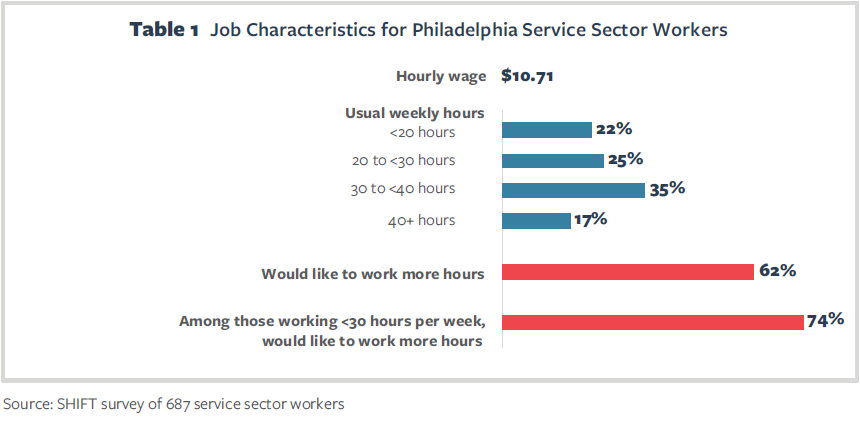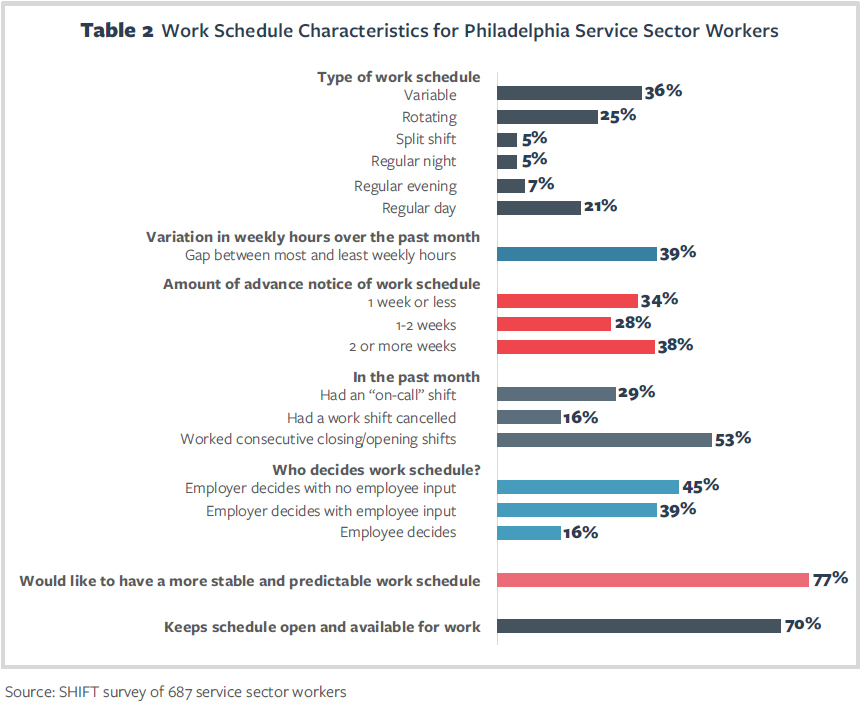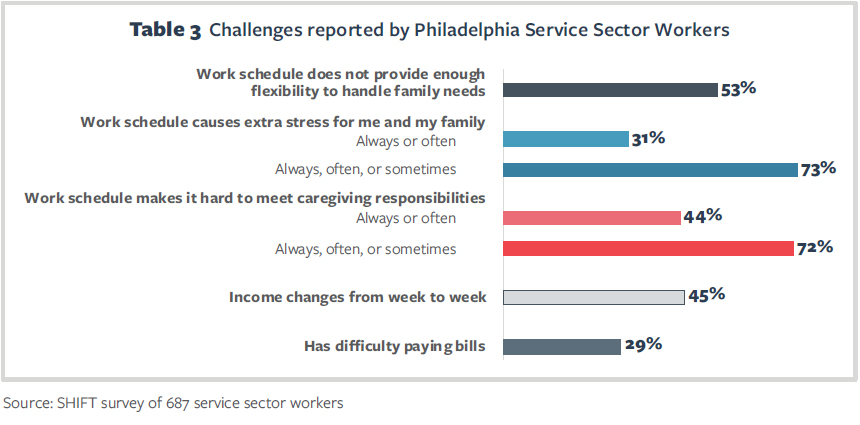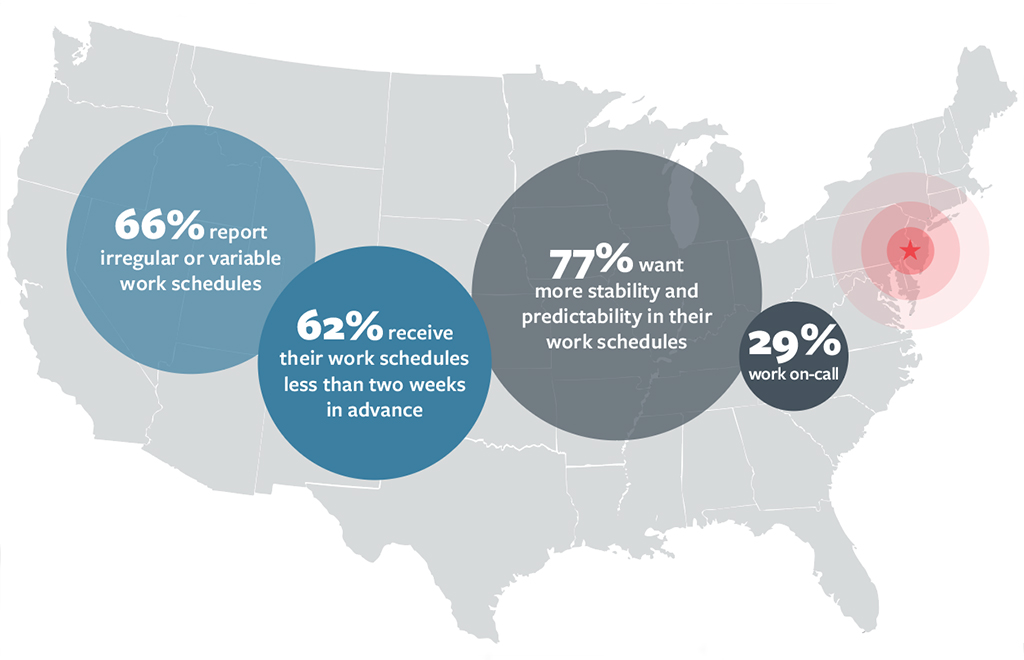Nearly 100,000 workers are employed in the retail and food service sector in the Philadelphia metropolitan area.1 Nationally, jobs in the service sector are characterized by low pay and few fringe benefits, and workers employed in the service sector have little control over the days and times that they will work.2 In addition, many service sector employers across the country rely on just-in-time and on-call scheduling practices designed to minimize labor costs by closely aligning staffing with consumer demand.3 These practices can introduce a great deal of instability into the lives of workers and their families.4
This research brief is part of series designed to advance our understanding of work conditions in the service sector – in particular schedule instability and unpredictability – in cities and states across the country. The Shift Project is collecting survey data from workers employed at large chain retailers and food service establishments across the country.5 We ask workers about their work schedules, household economic security, health, and wellbeing – allowing insight into work schedules and family life that is not available in other existing data.
The Shift Project data permit an unprecedented view of labor conditions for workers in Philadelphia, employed at the large firms that are the focus of recent state and local labor regulation. This research brief describes the experiences reported by 687 service sector workers in the Philadelphia area.
Wages and Work Hours
For workers paid hourly, their earnings are determined by their hourly wage and number of scheduled hours. Many Philadelphia workers reported wages and hours that fall short of what they would need to make ends meet. Although Pennsylvania’s Governor Tom Wolf and other Pennsylvania legislators have proposed raising the state minimum wage to $12, so far no legislation has been passed and most workers currently earn less than this proposed minimum.
Philadelphia service sector workers reported, on average, an hourly wage of $10.71. Almost 40% of these workers report earning $9 per hour or less. For most workers, hourly wages fall substantially below estimates of a living wage, which is calculated based on what would be required to afford basic necessities assuming full-time year-round work. In Philadelphia, the living wage for a single person with no children is estimated to be $11.70 and for a single parent with one child is $23.64 per hour.6 Of note, these living wage estimates assumes consistent full-time work, an assumption that applies to only a small minority of Philadelphia service sector workers.
In fact, 22 percent of Philadelphia service sector workers usually work less than 20 hours per week. Another 25% usually work between 20 and less than 30 hours. Thirty-five percent report working between 30 and less than 40 hours per week, and only 17% work at least 40 per week. Yet, even though a large majority of workers work less than full time (83%), only a small minority of workers (less than 15%) augment their work hours with a second job. Some suggest that workers may prefer this kind of part-time employment. We tested this explanation directly by asking workers whether they “would like to work more hours.” It is illuminating that 62% of workers in our sample overall, and 74% among those working less than 30 hours per week, reported that they would like to work more hours.
Unstable and Unpredictable Work Schedules
In addition to wide-spread part time hours, we also find that Philadelphia workers experience unstable and unpredictable work schedules, along several dimensions.
Two-thirds of workers describe their work schedules as irregular or variable. Specifically, 36% report “variable” work schedules and 30% report “rotating” or “split shifts.” Another 12% of workers report regular, non-standard night or evening schedules. Only 21% of service sector workers report a regular daytime work schedule, and everyone else has either an irregular, unstable, or non-standard work schedule.
Philadelphia workers also experience a great deal of variation in the number of hours worked each
week. The average worker reported a gap of 14 hours between the week they worked the most hours and
the week they worked the fewest hours over the past month. In percentage terms, that is almost a 40% gap between the hours worked in the week with the most hours and that with the fewest. Given our focus on hourly workers, these variations in hours will then lead automatically to volatility in earnings.
In addition to the common experience of schedule instability, most workers receive limited advanced notice of their work schedules. Thirty-four percent of workers receive less than 1 week advance notice of their schedule, and another 28% receive at least 1 week but less than 2 weeks’ notice. Recently, several states and localities have passed labor regulations requiring two weeks’ advance notice of work schedules. In the Philadelphia area, only 38% of workers report receiving two or more weeks of advanced notice.
Workers reported on experiencing specific types of schedule instability in the past month. Twenty-nine percent of workers reported working an “on-call” work shift, meaning that they kept their schedule open and available for work but may or may not actually work the shift. Sixteen percent of workers reported having a shift cancelled in the past month. More than half of workers reported that they worked consecutive closing then opening shifts, referred to as “clopening.”
These measures show that many Philadelphia service sector workers experience unstable and unpredictable work schedules. We also find that these workers often do not have control over their scheduled days and times of work. Forty-five percent of workers have no input into their work schedules. Almost 40% have some input, and only 16% have a large degree of control over their scheduled work days and times. This variability and lack of control is indicative of schedule instability and unpredictability. But, some would suggest that these experiences reflect workers’ own desires for schedule flexibility. We tested this explanation directly by asking workers whether they would “like to have a more stable and predictable work schedule.” The results are telling. The large majority of workers (77%) expressed a desire for more stability and predictability in their work schedules.
In addition to asking about instances of schedule instability over the past month, we also asked workers more whether they had to keep their schedule open and available for work. Strikingly, 70% of workers reported that they kept their schedule open and available for work. When workers are keeping their schedules open and available for work, this has implications for their ability to balance work and family responsibilities, to combine work with schooling or other pursuits, and to achieve a work/life balance.
Challenges reported by Philadelphia Workers
The Shift survey also asked workers to report on whether their work schedules interfered with their family needs and caregiving responsibilities. These types of conflicts were common. More than half of workers express that their work schedule does not provide enough flexibility for them to handle family needs. Nearly one-third of workers say that their work schedule is a chronic source of extra stress for their family and almost three-quarters say that their work schedule sometimes, often, or always causes extra stress. Forty-four percent say that their work schedule always or often makes it hard to meet their caregiving responsibilities, and an even larger share (72%) experience conflicts between work and their caregiving responsibilities sometimes, often, or always.
Another consequence of unstable work hours is unstable earnings and accompanying financial challenges. A large share of workers (45%) report that their income changes from week to week, and 29% report that they have difficulty paying their bills.
Discussion
The Shift Project survey of service sector workers provides a window into the experiences of workers employed at large retail and food establishments across the nation and in particular locales. This brief describes the experiences of workers in the Philadelphia metropolitan area.
The portrait of Philadelphia service sector workers reveals that unstable and unpredictable schedules are the norm. As we have seen nationally, the retail and food sectors in Philadelphia are characterized by low pay, insufficient work hours, and a lack of control over scheduled work hours. With the new Shift Project data, we can also see in detail how these workers also contend with schedules that are announced with little notice and often changed at the last minute. By hearing directly from workers we can learn not only about their experiences, but about their preferences. The large majority of workers express a desire for more work hours and more predictability in their work schedules.
Scheduling practices are beginning to change, however, as some localities have passed labor laws that regulate work schedules. San Francisco and Seattle and New York and Oregon State have all passed legislation requiring a certain amount advance notice of work schedules (usually two weeks) and stipulating that workers be compensated by employers when their shifts are changed on shorter notice. These new labor regulations also include an “access to hours” provision, requiring that employers offer additional hours to their part-time workers before hiring additional part-time employees.
Philadelphia is also considering similar legislation. The findings from the Shift Project provide evidence that legislation mandating advance notice of work schedules and shift changes, and access to more hours would have a major impact on the day-to-day lives of workers in the service sector in Philadelphia and would be responsive to the desire of workers to have more hours and more predictability to their work schedules.



Endnotes
- https://www.bls.gov/oes/current/oes_37964.htm
- Lambert, S. J. 2008. “Passing the Buck: Labor Flexibility Practices that Transfer Risk onto Hourly Workers.” Human Relations 61(9): 1203-1227.
- Golden, L. 2015. “Irregular Work Scheduling and Its Consequences.” Briefing Paper #394. Economic Policy Institute; Appelbaum, E., A. Bernhardt, and R.J. Murnane. (Eds.). 2003. Low-Wage America: How Employers are Reshaping Opportunity in the Workplace. New York: Russell Sage Foundation; Clawson, D., and N. Gerstel. 2015. Unequal Time: Gender, Class, and Family in Employment Schedules. New York: Russell Sage Foundation.
- Lambert, S.J., P. Fugiel, and J.R. Henly. 2014. Precarious Work Schedules among Early-Career Employees in the US: A National Snapshot. University of Chicago.
- Further details about our data collection and methodology are presented in an Appendix at the end of this brief.
- The Living Wage Calculator, created by Dr. Amy K. Glasmeier, Professor of Economic Geography and Regional Planning at MIT.
